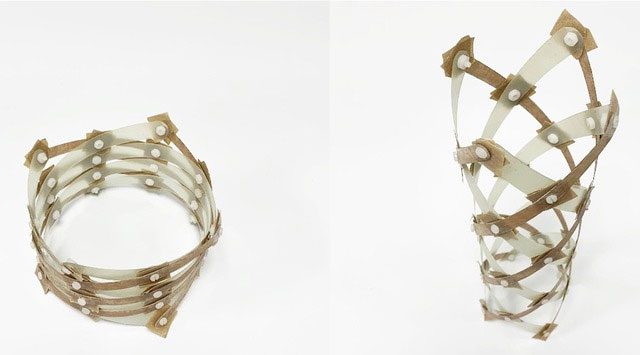This flexible antenna can be used in emergency situations.
Typically, to establish communication systems from locations lacking signal, such as areas recently affected by natural disasters, rescue teams have to set up bulky, expensive satellite dishes. However, with the newly developed device, a lightweight, adjustable cylindrical antenna, the process of setting up communication systems becomes significantly simpler.
Developed by scientists from Stanford University and the American University of Beirut, the prototype device shown in the image below is called the bi-stable deployable quadrifilar helix antenna. Simply put, this type of antenna consists of one or more conductive wires twisted in a helical shape (similar to a corkscrew) around a central pillar.

The bi-stable deployable quadrifilar helix antenna consists of 4 twisted wires.
With its lengthy name, “bi-stable deployable quadrifilar helix antenna” eliminates the need for a support pole and replaces traditional conductive wires with strips of conductive composite material – these are twisted together in a helical shape to form a hollow cylinder.
Importantly, this hollow cylinder can be extended into a structure approximately 305 mm long or compacted into a ring measuring 25×127 mm.
In its extended state – when connected to electronic devices such as transceivers, ground planes, or batteries – the antenna emits low-power signals in all directions, allowing users to communicate via radio waves. In its compact state, it transmits high-power signals in a specific direction, enabling communication with satellites.

The antenna is twisted together to form a hollow cylinder.
One factor that simplifies the installation of the device is its two-state structure. This means that when pulled or pushed by hand, it will automatically switch to the desired state, allowing users to easily verify if it has been deployed correctly. This compact device can be utilized in disaster zones, on battlefields, or even aboard spacecraft in outer space.
“Traditional solutions often involve heavy metal dishes. They are difficult to transport, require a lot of energy to operate, and are particularly cost-ineffective,” said Associate Professor Maria Sakovsky from Stanford University. “Our antenna is lightweight, consumes low power, and can switch between two operational states.” It is a highly suitable device for deployment in areas lacking communication methods.
A scientific report on this project has been published in the journal Nature Communications.




















































